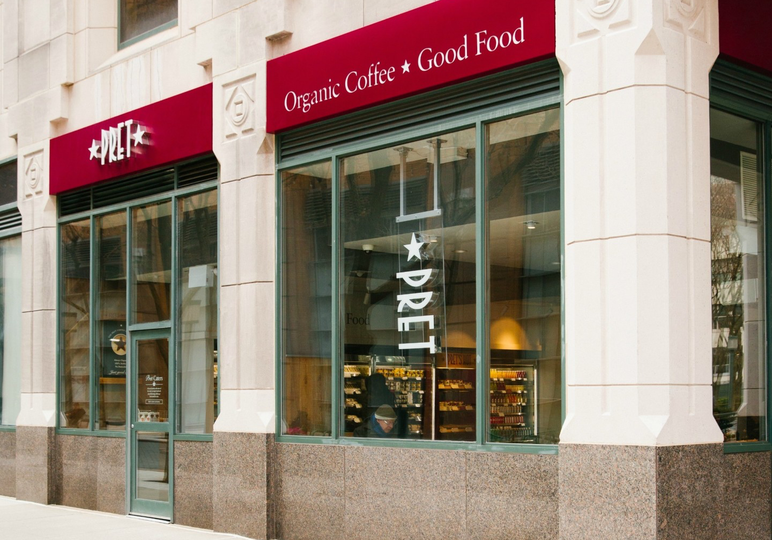‘The Pret Index’ highlights working from home trends
Pret sandwich sales are a surprisingly good indicator of how many workers aren’t returning to the office.

If sandwich sales are any guide, London’s bankers, corporate lawyers and asset managers are taking their time returning to offices even as the pandemic eases across the U.K.
That’s shown in data from Pret A Manger, the restaurant chain that typically sold about 200,000 lattes and 100,000 croissants a week to Britain’s office workers, shoppers and commuters before Covid struck.
The figures compiled by Pret, whose expansion to some 300 London stores was fueled by the city’s thriving economy before the coronavirus, are a real-time gauge of the U.K.’s recovery from its worst recession in three centuries and provide one look at how the U.K. is getting back to normal.
In a geographical cluster that includes the City and Canary Wharf, London’s two major financial districts, business remains relatively slow.
Although some employers are encouraging workers to return, official U.K. government guidance is that those who can work from home should do so until June.
Although the return to school and the reopening of non-essential retailers gave a boost to business in nearby fast-food outlets, financial districts will continue to lag behind, Pret Chief Executive Officer Pano Christou said in an interview.
“I think working habits will be different for the long term,” he said. “Hybrid, flexible working is a thing now and will stay. Our view is that the City will take many, many years to come back.”
Sandwich-shop transactions aren’t a perfect measure, and other indicators, such as public-transport traffic, will help complete the picture.
Still, the data give a sense of where there’s demand for breakfast and lunch – as well as for labor, since shops such as Pret employ many of the 3 million workers in Britain’s hospitality industry.
Traffic is equally slow in the Pret cluster that includes London Heathrow and Gatwick airports. Airlines have grounded many flights, with Britons barred from taking overseas vacations or non-essential trips until at least May 17.
Last week, the U.K. government announced a list of 12 destinations where vacationers can fly from that date without having to quarantine upon returning.
“I don’t think we’re going to see much of a pickup on May 17 in airports,” Christou said. “If Mediterranean Europe or the U.S. go onto the green list, that’s when we’ll see a bigger step up.”
Train stations are in slightly better shape than airports, though still struggling.
More encouraging are the signs of life from Pret’s cluster in London’s West End, which includes shopping arteries such as Oxford Street and Bond Street, home to some of the country’s largest department stores and designer boutiques.
Non-essential stores were allowed to reopen on April 12.
Pret sales in suburban London suggest that residents are ordering at pre-pandemic levels, even if they’re sticking closer to home. While the Pret chain historically had a growth strategy based on following new office towers, its new aim is to sell to people where they live.
Christou said the chain’s business in the shopping centers of York and Leeds is recovering strongly, thanks to customers emerging from lockdown with higher savings – but business in Scotland has languished, reflecting tighter lockdown rules than in England.
Pret heads home
Christou has scrapped Pret’s “follow the skyscraper” expansion program focused on city-center locations. Now, growth will come from deliveries, a loyalty program, sales in supermarkets and by moving stores to where customers are living outside of London.
His remarks highlight the upheaval London’s economy is facing after the government ordered offices closed for much of the past year to control the pandemic. Christou is among a growing number of executives anticipating a permanent shift in working patterns and will adapt Pret’s business as a result.
“The city will be very different to before Covid,” Christou said in an interview in late April. “We won’t be going back to the days of working in the office four of five days a week. Flexible working is here to stay.”
It also upends Pret’s strategy, which previously relied on opening new shops mostly in urban areas. The company only recently developed a customer loyalty program and started embracing online sales and deliveries. Christou’s remarks suggest many of his stores may face a long-lasting decline in sales.
Pret has 389 shops in the U.K., 340 of which are in London, giving it a big stake in the city’s economy and making it a bellwether of the hospitality industry. Many of its locations were closed after Covid-19 hit Britain more than a year ago, and almost all have reopened.
It permanently shut 30 stores last summer at the height of the pandemic and is now looking for ways to firm up its business as infections decline and Prime Minister Boris Johnson loosens lockdown rules.
Christou’s sense is that more people are leaving the city for suburbs, and Pret needs to go where the people are instead of waiting for them to show up to a store near an office.
“If you have a Pret when you’re at work, great, but there’s a big opportunity for us to have more Prets where people are living as well,” he said.
To draw in new customers, it has joined forces with delivery apps such as Deliveroo, Just Eat and Uber Eats. It’s also marketing drinks in supermarkets and through a subscription service, hoping to build loyalty.
Asked whether Pret overbuilt in London before the crisis, Christou said, “We made the right decisions at the right time” and that there’s no plan now to close more stores.
“The staff we have now are the staff we’ll keep. We won’t be looking to reduce staff’s hours if customers come in two or three days a week.”
Britain’s departure from the European Union has put pressure on Pret by creating more paperwork for imports and exports. It also may dry up the supply of workers the company has depended on to staff its stores.
“As soon as the Brexit vote came through, we saw a significant drop in EU workers applying for jobs in Pret,” he said. “As a business, we need to ensure that we’ve got an appealing offer to entice people.”
This article is published under license from Bloomberg Media: the original article can be viewed here
